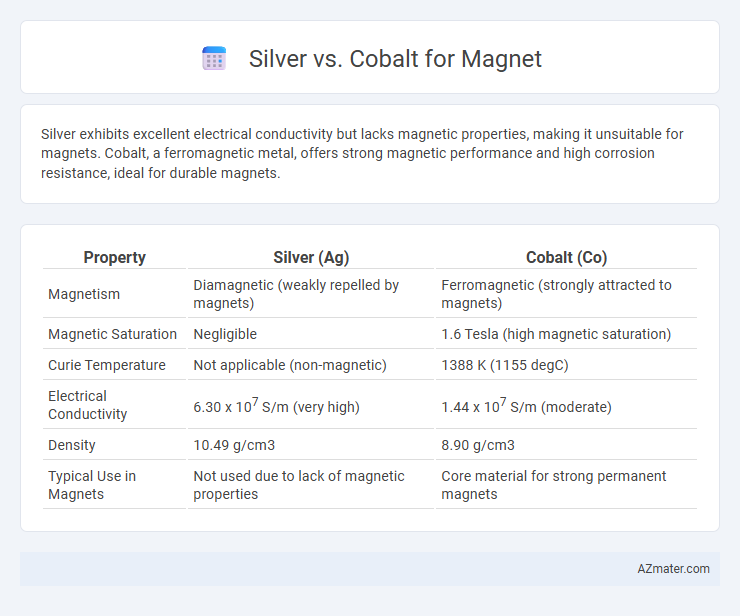Silver exhibits excellent electrical conductivity but lacks magnetic properties, making it unsuitable for magnets. Cobalt, a ferromagnetic metal, offers strong magnetic performance and high corrosion resistance, ideal for durable magnets.
Table of Comparison
| Property | Silver (Ag) | Cobalt (Co) |
|---|---|---|
| Magnetism | Diamagnetic (weakly repelled by magnets) | Ferromagnetic (strongly attracted to magnets) |
| Magnetic Saturation | Negligible | 1.6 Tesla (high magnetic saturation) |
| Curie Temperature | Not applicable (non-magnetic) | 1388 K (1155 degC) |
| Electrical Conductivity | 6.30 x 107 S/m (very high) | 1.44 x 107 S/m (moderate) |
| Density | 10.49 g/cm3 | 8.90 g/cm3 |
| Typical Use in Magnets | Not used due to lack of magnetic properties | Core material for strong permanent magnets |
Introduction: Silver vs Cobalt in Magnetism
Silver exhibits weak diamagnetic properties with minimal magnetic susceptibility, making it unsuitable for strong magnet applications. Cobalt, a ferromagnetic metal, displays significant magnetic strength and high Curie temperature, essential for permanent magnets and electromagnetic devices. The stark contrast between silver's negligible magnetism and cobalt's robust magnetic characteristics defines their roles in magnet design and technology.
Physical and Chemical Properties of Silver and Cobalt
Silver exhibits excellent electrical conductivity and high ductility, with a melting point of 961.8degC and resistance to oxidation, maintaining its lustrous appearance over time. Cobalt, characterized by a melting point of 1495degC, offers superior magnetic properties due to its ferromagnetism and high Curie temperature around 1121degC, making it ideal for permanent magnet applications. Chemically, silver is relatively inert but can tarnish in sulfur-containing environments, whereas cobalt is more reactive, forming stable oxides that contribute to its corrosion resistance in various conditions.
Magnetic Characteristics: Silver Compared to Cobalt
Cobalt exhibits significantly stronger magnetic properties than silver due to its ferromagnetic nature, making it ideal for high-performance magnets and electromagnetic applications. Silver is diamagnetic, meaning it weakly repels magnetic fields and lacks permanent magnetization, rendering it unsuitable for use as a magnetic material. The high Curie temperature of cobalt, around 1,115degC, allows it to maintain magnetism under extreme conditions, whereas silver shows negligible magnetic response across temperatures.
Common Applications of Silver Magnets
Silver magnets, known for their excellent electrical conductivity and resistance to corrosion, are commonly used in high-performance electrical contacts, sensors, and precision instruments where reliability and efficiency are critical. Unlike cobalt magnets, which excel in high-coercivity and magnetic strength for industrial motors and turbines, silver-based magnetic applications prioritize conductive pathways in microelectronics and communication devices. The superior thermal and chemical stability of silver enhances performance in aerospace and medical sensor technologies, distinguishing its role from cobalt in magnet applications.
Predominant Uses of Cobalt Magnets
Cobalt magnets, primarily known as samarium-cobalt (SmCo) magnets, excel in high-performance applications requiring superior temperature stability and corrosion resistance, making them predominant in aerospace, military, and medical devices. Unlike silver, which is valued for electrical conductivity and decorative uses, cobalt magnets deliver strong magnetic fields and maintain performance in extreme environments, critical for precision instruments and electric motors. Their reliability in harsh conditions distinguishes cobalt magnets as essential components in advanced technology sectors, surpassing silver's role in magnetism.
Cost Analysis: Silver vs Cobalt Magnets
Silver magnets generally incur higher costs due to silver's market price volatility and lower abundance compared to cobalt, which is relatively more stable in price. Cobalt magnets, specifically those used in samarium-cobalt (SmCo) magnets, offer a more cost-effective solution with excellent magnetic strength and temperature resistance, making them preferable for industrial applications. Considering cost per performance, cobalt magnets provide better value in high-temperature and durable use cases, while silver magnets remain rare and expensive for magnetic applications.
Durability and Longevity of Silver and Cobalt Magnets
Cobalt magnets exhibit superior durability compared to silver-based magnets, withstanding higher temperatures and resisting corrosion more effectively. Silver, while having good electrical conductivity, lacks the magnetic properties and structural robustness necessary for long-term magnet performance. Cobalt's magnetic alloys, such as samarium-cobalt, provide exceptional longevity and stability in demanding environments, making them ideal for industrial and technological applications.
Environmental Impact: Silver vs Cobalt Extraction
Silver and cobalt extraction both pose significant environmental challenges, with cobalt mining often linked to severe ecological degradation and toxic waste due to its prevalence in sensitive areas like the Congo Basin. Silver mining generates large quantities of waste rock and tailings, leading to water contamination and habitat disruption, but typically has a lower overall carbon footprint compared to cobalt mining. Sustainable practices and stricter regulations are crucial to mitigating the negative environmental impact of both metals used in magnet production.
Performance Differences in Industrial Settings
Silver magnets exhibit high electrical conductivity but relatively low magnetic strength, limiting their use in industrial magnet applications where strong magnetic fields are essential. Cobalt magnets, particularly in alloys like Alnico and samarium-cobalt, provide superior magnetic performance with greater coercivity and temperature stability, making them ideal for high-performance industrial environments. Industrial settings requiring durable, high-strength magnets prioritize cobalt-based materials for efficient energy use and enhanced operational reliability.
Which Is Better for Your Needs: Silver or Cobalt Magnets?
Cobalt magnets, especially samarium-cobalt types, offer superior temperature stability, corrosion resistance, and strong magnetic strength, making them ideal for high-performance applications and harsh environments. Silver, while a valuable and conductive metal, is rarely used as a magnet material because it lacks inherent magnetic properties, so it is not suitable for magnet-based needs. For most magnetic applications, cobalt magnets provide better reliability and efficiency compared to silver, which is primarily used for electrical and decorative purposes.

Infographic: Silver vs Cobalt for Magnet
 azmater.com
azmater.com